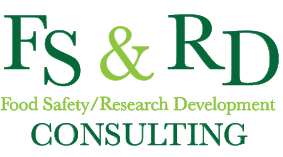Allergen Management Program - Why it is so important?
Over half of the recalls in Canada are due to a product that contains an undeclared allergen. An allergen is a substance that is foreign to the body and can cause an adverse reaction in certain people. For example, pollen, nuts or mold. This adverse food reaction can either be a food intolerance or a food allergy. Allergic reactions to foods can be vary from mild gastrointestinal discomfort, to skin rashes and/or potentially life threatening asthma and anaphylaxis. For the purpose of this article we will focus on the allergens that the Canadian Food Inspection Agency require to be effectively controlled within food facilities.
These allergens are: Egg, Dairy - Milk and milk ingredients, Wheat, Gluten, Soy, Fish / Crustaceans / Shellfish, Peanuts, Tree nuts, Sesame, Mustard and Sulphites at a level >10 ppm.
The allergen management program needs to outline how you will identify and control:
1) upon receiving and storing
2) ingredients and product through the processing
3) of packaging and labelling
Received & Stored Allergens :
It is important that you store allergen-containing materials in a manner that cannot cross contaminate other non-containing allergen (e.g. packaging closed, intact). One common practice is to sticker allergen containing products with different coloured stickers so that you can identify the types of allergens that you have.
Maintaining a segregated area within your storage area for allergen containing ingredients makes it easier to ensure that they don't contaminate other ingredients. By ensuring that you always store non allergenic ingredients above allergenic ones or by storing ones with a lesser number of allergens above those with more of the same allergens, you can minimize any risk that a spill would potentially contaminate the other non allergenic ingredients.
Processing:
There are two key actions that will control allergens as they are being processed within your facility. The first is ensuring scheduling arranges products with no-allergens to be run first, before products that contain allergens. Products with allergens will be scheduled later and in order by number of allergens. i.e. one with soy to be done before one with soy and wheat.
At times you may not be able to schedule allergens in this fashion and may need to produce the allergen product first. If this occurs then you will require a full cleaning prior to the changeover to the non-allergen. This cleaning process would need to be validated to ensure that it removes the allergenic protein effectively.
The second action is to ensure that all transfer equipment - scales, buggies, carts, racks, scoops etc. are kept for the allergen products. A few ways that this can be done would be to colour code them or tag them so that they can easily be identified which allergenic products it is being used for.
Special care will likely need to be taken around the ovens and cooling if they are found within your process as this is often where multiple products are kept together prior to packaging.
Packaging and Labelling
Packaging and labelling is important as this is where employees will need to ensure that the right package or label is applied to the product. You may have two products that are extremely close in visual appearance but one contains an allergen and the other doesn't. (i.e. regular hot dog, hot dog stuffed with cheese). Therefore, you should ensure that you have checks and balances to ensure the right label is getting onto the correct product. Removing packaging from the floor prior to converting to a new product helps to ensure that incorrect packaging isn't accidentally placed on the wrong product.
This step starts, however, when the labels are developed to ensure that all allergens are included on the label. Therefore, strong relationships with your suppliers is important to make sure you always have correct specification / ingredient information. Then, it is important that you take great care during the creation of the new label to ensure that all allergens are included on the label. You also need to review your process to determine whether you can effectively eliminate all allergens. If you can't then you do need to use a may contain statement. For example, in a bakery where sesame seeds are being used, it may not be possible to ensure 100% elimination of this allergen and therefore you would need to put this on the label as a "may contain sesame" statement.
By effectively maintaining and controlling allergens as they pass through your facility you can keep your name off the "Undeclared allergens" recall list. Just one more way to maintain brand integrity. If you feel that there is more that can be done with your program and you aren't sure where to start, feel free to email me at melissastevenson@fsrdconsulting.com or check out my website at www.fsrdconsulting.com. I can review and identify any areas of improvement that you may wish to make.
